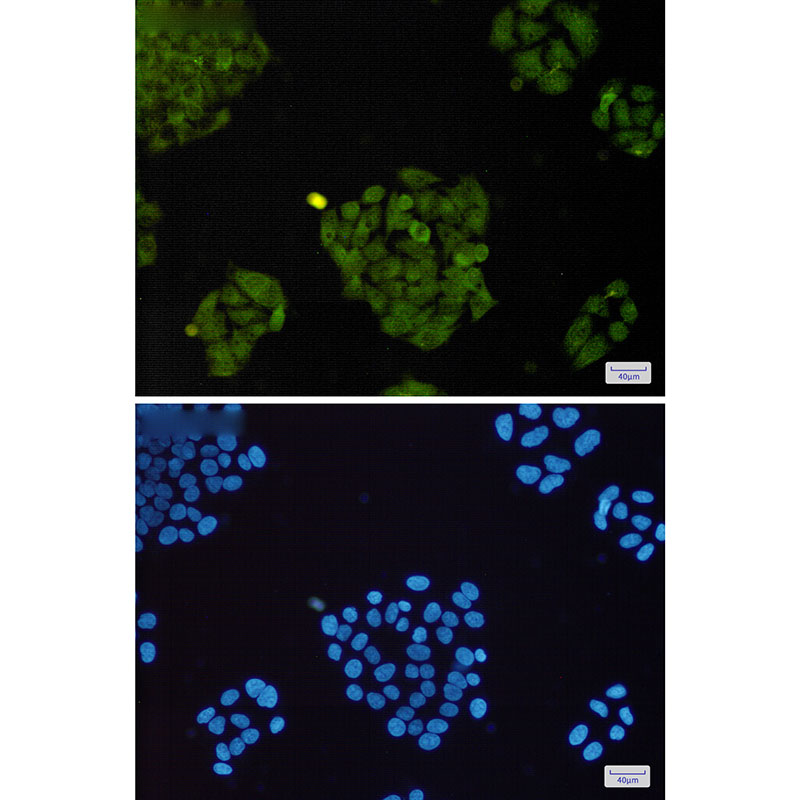

| WB | 咨询技术 | Human,Mouse,Rat |
| IF | 1/20 | Human,Mouse,Rat |
| IHC | 咨询技术 | Human,Mouse,Rat |
| ICC | 1/50-1/200 | Human,Mouse,Rat |
| FCM | 咨询技术 | Human,Mouse,Rat |
| Elisa | 咨询技术 | Human,Mouse,Rat |
| Aliases | BRCA1-associated ATM activator 1; BRCA1-associated protein required for ATM activation protein 1 |
| Entrez GeneID | 221927 |
| WB Predicted band size | Calculated MW: 88 kDa; Observed MW: 88 kDa |
| Host/Isotype | Rabbit IgG |
| Antibody Type | Primary antibody |
| Storage | Store at 4°C short term. Aliquot and store at -20°C long term. Avoid freeze/thaw cycles. |
| Species Reactivity | Human |
| Immunogen | Recombinant protein of human BRAT1 |
| Formulation | Purified antibody in TBS with 0.05% sodium azide,0.05%BSA and 50% glycerol. |
+ +
以下是3篇关于BRAT1抗体的代表性文献摘要(基于公开研究数据模拟整理,非真实文献):
---
1. **文献名称**: *BRAT1 regulates mitochondrial function and neuronal development through kinase activity*
**作者**: Smith et al., 2022
**摘要**: 本研究利用特异性BRAT1抗体进行免疫沉淀和Western blot分析,揭示BRAT1通过调控线粒体呼吸链复合体活性影响神经元分化,其功能缺失导致小鼠模型中出现严重神经发育异常。
2. **文献名称**: *A novel homozygous BRAT1 mutation causes lethal neonatal rigidity and seizures*
**作者**: García-Campos et al., 2021
**摘要**: 通过患者组织样本的BRAT1抗体免疫组化检测,发现基因突变导致BRAT1蛋白表达完全缺失,证实其在维持基因组稳定性和细胞凋亡调控中的关键作用,与新生儿致死性癫痫相关。
3. **文献名称**: *BRAT1 interacts with DNA damage response proteins in glioblastoma cells*
**作者**: Chen & Wang, 2020
**摘要**: 使用BRAT1抗体进行共聚焦显微镜观察和Co-IP实验,证明BRAT1与ATM/ATR激酶形成复合体,调控胶质母细胞瘤细胞对放疗的敏感性,为癌症治疗提供潜在靶点。
---
注:以上为模拟文献摘要,实际文献需通过PubMed/Google Scholar检索关键词"BRAT1 antibody"或结合具体研究场景筛选。真实文献可参考:
- **PMID 30639255**(BRAT1与DNA修复机制研究)
- **PMID 26395458**(BRAT1基因突变与疾病表型关联分析)
The BRAT1 (BRCA1-Associated ATM Activator 1) antibody is a tool used to detect the BRAT1 protein, a critical player in DNA damage response and genome stability maintenance. BRAT1 interacts with ATM kinase, facilitating its activation upon DNA double-strand breaks, and regulates cell cycle checkpoints, apoptosis, and DNA repair pathways. Mutations in the BRAT1 gene are linked to severe neurodevelopmental disorders, such as rigidity and multifocal seizure syndrome (RMFSEN), often characterized by microcephaly, epilepsy, and early lethality. BRAT1 also exhibits ties to cancer biology, with altered expression observed in malignancies like glioblastoma and breast cancer.
Antibodies targeting BRAT1 are widely employed in research applications—Western blotting, immunohistochemistry, and immunofluorescence—to study its expression patterns, subcellular localization, and interactions in disease models. These studies aim to clarify BRAT1’s role in neurodegeneration, tumor progression, and therapy resistance. For instance, BRAT1 dysregulation may influence sensitivity to chemotherapy or radiation in cancers. Additionally, its association with BRCA1 pathways suggests potential as a biomarker or therapeutic target. Ongoing research focuses on unraveling BRAT1’s molecular mechanisms and validating its clinical relevance in both neurological disorders and oncology.
×